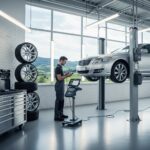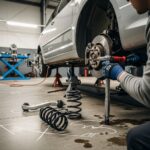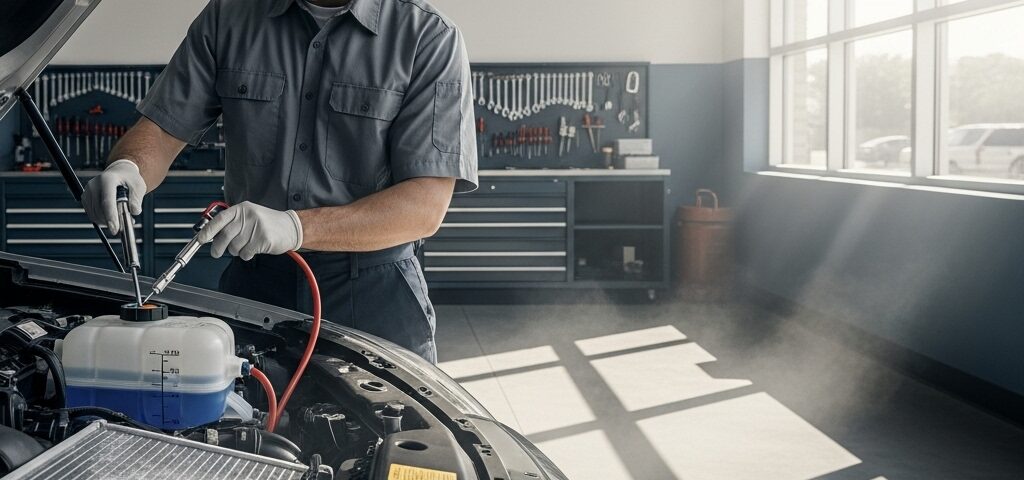
European Auto Repair Specialists In Thousand Oaks California
October 23, 2025
Brake And Suspension Auto Repair In Thousand Oaks California
October 23, 2025When summer settles over Thousand Oaks, the air turns bright and dry, the hills shift from green to gold, and cars begin to reveal how they’ve handled the heat. Those long, shimmering afternoons along the 101, the steady climb up the Conejo Grade, and the slow rolls through parking lots at The Oaks all ask for systems that stay cool and composed. Preventive auto care in our climate is less about chasing problems and more about setting the stage so your car thrives when the mercury jumps. As someone who has spent years under hoods and on road tests from Newbury Park to Lake Sherwood, I’ve learned that a few thoughtful habits before and during summer can change the entire season of driving. If you’re looking for a place to begin, a useful reference is this Auto Repair that can help frame your options.
Hot weather influences everything your car does. Rubber gets softer, fluids thin, electrical resistance rises, and the cabin becomes a test of air conditioning performance. Thousand Oaks adds its own character: afternoon winds can carry dust that coats condensors and filters, evening temperature drops cause tire pressures to swing, and weekend canyon drives place unique demands on brakes and cooling. That’s why we think in systems, not just parts. A cooling check touches belts, hoses, caps, pumps, fans, and coolant chemistry. An A/C service clarifies refrigerant charge, condenser health, and blend door function. Each element plays a role in a car that feels the same at 2 p.m. as it does at 8 a.m.
Cooling system readiness before the heat hits
The path to a calm summer starts with the cooling system. Coolant condition matters because its additives prevent corrosion and raise the boiling point. We test pH and protection, pressure-check for leaks, and inspect the radiator and heater core for telltale staining. On the Conejo Grade, marginal cooling will show itself in a creeping gauge or a fan that runs constantly even on gentle slopes. Electric fans need proper control signals; viscous clutches must engage cleanly. A weak cap that can’t hold pressure undermines the entire system, and a small drip at a hose clamp can escalate under heat-soak after a highway run.
Water pumps deserve specific attention. Some designs use composite impellers; others are metal. Either way, bearing wear and seal seepage can be subtle until a long hot day pushes them over the edge. We look for weep holes with dry crust, belt dust, and tiny traces that suggest movement. Replacing a pump before it fails turns a stressful breakdown into a footnote in your maintenance log.
Air conditioning that keeps its cool
A Thousand Oaks summer is the ultimate A/C exam. When the car sits in the sun, plastics radiate heat that takes many minutes to purge unless the system is healthy. We verify charge pressures, condenser cleanliness, and fan operation, then measure vent temperatures under controlled conditions. A slightly low charge can mimic a bigger problem; debris on the condenser can act like a blanket. Blend doors and actuators ensure the air actually goes where you ask. Cabin filters loaded with dust from windy days restrict airflow, making the blower work harder and the system less effective. The goal is simple: quick cooldowns, stable temperatures, and low noise from the vents.
On hybrids and EVs, A/C has an extra role: thermal management for batteries and power electronics. That means correct refrigerant type, clean condensers, and precise charge matter even more. We include those checks in seasonal prep so efficiency and component longevity stay where they should.
Fluids, friction, and summer margins
Heat thins fluids, which can change how components behave. Oil that’s fresh protects better under load; transmission fluid with healthy additives guards against shear and heat during climbs and stop-and-go. Brake fluid’s boiling point drops as it absorbs moisture over time, so a flush before summer can be a smart move if it’s due. Power steering fluid, where applicable, and differential fluids also benefit from being in good condition before the most demanding months arrive.
In practice, we tailor intervals to your driving. If your routine includes gentle morning commutes and shaded parking, you may be fine on standard schedules. If you regularly idle in late-afternoon traffic with the A/C on high, moving slightly earlier on certain services helps keep everything composed. Thousand Oaks’ pattern of cool mornings and hot afternoons exaggerates contrasts that vehicles feel acutely.
Tires, alignment, and the hot road
Tires are where summer heat meets the pavement. Pressures rise as the day warms, which changes contact patch and steering feel. We set pressures cold, verify TPMS readings, and inspect for shoulder wear or cupping that shows alignment drift or worn dampers. On the 101, sustained speeds make small imbalances more obvious; in parking lots, tight turns reveal worn bushings or dry ball joints. Rotations and alignments keep the car tracking straight and the wheel centered, even when expansion joints try to pull you around.
Rubber components—belts, hoses, wiper blades—age faster in summer. We flex-test hoses for softness or cracks, check belt tensioners for wobble, and replace tired blades so those rare monsoon bursts are uneventful. Window seals and weatherstripping also benefit from a quick inspection; keeping the cabin sealed preserves A/C performance and keeps wind noise low.
Brakes that stay confident in the heat
Hot rotors and pads behave differently. Long gentle braking into Camarillo can sneak heat into the system; a sudden stop in town then draws on components that are already warm. We assess pad composition, rotor condition, and caliper operation. Cleaning and lubricating slide pins keeps pads retracting properly, which reduces noise and uneven wear in the heat. For vehicles with adaptive or performance brakes, a test on local ramps verifies that modulation remains predictable.
One overlooked item is the parking brake. Cables and mechanisms can drag in hot weather if not exercised. We check function and adjust where needed so hill holds in steep driveways around Lake Sherwood feel solid and consistent.
Batteries and electrical systems under load
High temperatures accelerate chemical reactions in batteries, which can shorten life if the charging system isn’t healthy. We load-test batteries, confirm alternator output, and inspect grounds for corrosion. A battery that tested “okay” in spring can falter after weeks of hot starts and short trips with the A/C blasting. Clean terminals and solid grounds prevent voltage dips that lead to ghost warnings or infotainment glitches.
Lighting and visibility matter in summer too. Hazy headlight lenses and tired bulbs reduce nighttime clarity. We restore lenses and verify aim so you see cleanly without dazzling others. Fresh wiper blades and topped washer fluid finish the basics, ready for those few humid days when afternoon showers surprise everyone.
Keeping interiors cool and quiet
Cabins endure extreme swings in temperature. Plastics expand and contract, which can introduce rattles and squeaks that drive you a little crazy on longer trips. We chase those noises with patience—applying felt where panels meet, tightening clips, and ensuring nothing is loose under the dash. Sun-exposed dashboards appreciate protectants; leather benefits from gentle conditioning to prevent drying. These small touches add up to a car that feels cared for, not just serviced.
Odors often rise in summer. Evaporator cores can harbor condensation and organic material that create a musty smell. We use approved treatments that sanitize without damaging sensitive surfaces, paired with cabin filter replacement. The difference is immediate the next time you start the car after it has been sitting in the sun.
Planning your summer service
Timing is everything. The best moment for summer prep is late spring, when the first warm days arrive but before the deep heat settles in. That window lets us address findings on a comfortable schedule and ensures your car leaves ready for road trips, weekend canyon loops, and daily errands. If you miss the window, don’t worry; a well-structured visit can still reset the car mid-summer. We organize work to minimize downtime, provide updates by text, and coordinate pickups so you can keep your day moving.
Local road tests confirm the results. We’ll take the car up the Conejo Grade, loop back through Westlake Village, and idle in town to verify A/C performance in the worst-case scenario. If something needs a fine adjustment, we make it before you arrive so delivery is smooth and uneventful.
When you’re comparing options or planning your checklist, it helps to consult a clear resource like this Auto Repair so you know what thorough, locally informed preventive service looks like.
Frequently Asked Questions
Q: What’s the most important summer prep for Thousand Oaks driving? A: Cooling system health tops the list, followed closely by A/C performance. Heat exposes weak links quickly, and both systems determine whether a hot day feels routine or frustrating.
Q: How often should coolant be changed? A: Follow manufacturer intervals, but test condition seasonally. Coolant can be fine by time but tired by chemistry; a quick test confirms whether it still protects as designed.
Q: Why does my A/C work in the morning but struggle in the afternoon? A: Heat soak and condenser loading are common causes. We verify charge, clean the condenser, check fan control, and confirm blend doors are directing air properly.
Q: Do tires really need different care in summer? A: Yes. Pressures change with temperature, and hot pavement accelerates wear. Setting pressures cold and inspecting for alignment-tell wear patterns keeps handling consistent.
Q: Should brake fluid be changed before summer? A: If it’s approaching its interval or tests with high moisture content, yes. Restoring boiling point ensures confident stops even when components are already warm.
Q: How do I keep the cabin from smelling musty? A: Replace the cabin filter, treat the evaporator with approved cleaners, and run the fan briefly before shut-off to dry the core. These steps reduce odors significantly.
Q: Do EVs require special summer prep? A: They do. Battery and inverter cooling systems are critical, and A/C often supports thermal management. We verify those loops carefully along with standard checks.
Q: What if my car already runs hot? A: Stop and let it cool. Then schedule a focused inspection. We’ll pressure test, verify fan operation, and check for flow issues so we fix the cause, not just the symptom.
If the forecast shows another string of ninety-degree days and you’re not sure how your car will handle it, let’s get ahead of the heat together. We’ll tailor service to your driving, road-test on the routes you use, and deliver a car that stays composed when summer is at its peak. Reach out today and tell us about your plans—road trips, commutes, kid shuttles—and we’ll create a schedule that fits. To begin with a trusted local resource, follow this Auto Repair and take the easiest first step toward a cooler, calmer summer on the road.


